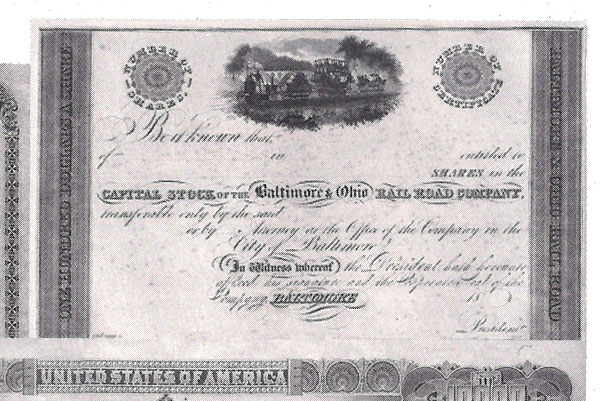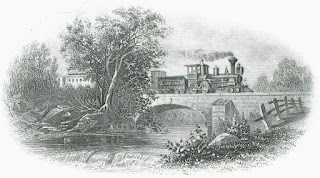The Crossing is one of the most iconic vignettes you will see on railroad certificates. The original version of the vignette first appeared in 1861 on bank notes produced by the National Bank Note Company, Several variations are known, but common elements include a passenger train crossing a bridge over a small creek. In the creek are five cattle and a boy holding a cane pole. A fence at the right outlines a trail where a man on horseback drives seven more cattle down toward the stream. At the point where the train crosses the track, a third man holds a sign. Two trees appear on both sides of the creek and lean inward to frame the scene.
The original version of
The Crossing is about 3.4 inches wide. The earliest known use in 1861 include appearances on a $1 bank note printed for the North Western Bank (Warren, Pennsylvania) and on a $500 Confederate States of America bank note (printed in Montgomery, Alabama.). Throughout the 1860s and 1870s, the original engraving plus many imitations appeared on numerous checks and bank notes, both in the United States and worldwide.
Records are frustratingly vague, but it is clear that National Bank Note Company paid an engraver named Robert Hinshelwood to create a vignette called
The Crossing in 1859. What is not clear is whether the famous version of
The Crossing was actually Hinshelwood's or his brother-in-law, artist and engraver James Smillie. Hinshelwood was married to Smillie's sister and the two were close. Hinshelwood produced engraved versions of several of Smillie's paintings and drawings, and for a short while both co-owned a company named Smillie & Hinshelwood.
Expert engravers contend the version we know as
The Crossing was Smillie's. Non-engravers who have seen and appreciated Smillie's other engravings contend this is largely Smillie's work. In my opinion, the borderline fanatical attention to detail is certainly a hallmark of Smillie's work like few others. Unlike other engravers, Smillie also liked to use trees and rocks to 'frame' and direct attention to important features.

One such Smillie-like detail can be found on the small sign held by the man at the right end of the bridge. The sign itself is only 0.083 inches (2.1 mm) wide. On that sign is the warning, 'Look Out For Bell Rings.' The letters are incredibly tiny, hard to see and even harder to reproduce. It is uncertain whether the warning sign referred to bells on trains, cattle, or both.
The enlargement of the sign at left was scanned from one of the Peruvian bonds mentioned below. The paper used for the printing was heavy and tough, so even though I scanned an original NBN engraving at 12,800 dpi, the lettering is still hard to decipher.
It was extremely common for steel-plate vignettes to be altered, expanded, trimmed down or re-engraved over time.
The Crossing is certainly among that number. The version shown at the top of this article (5" wide by 1.8" tall) is one that appears on 1872 bonds from the Compañia Nacional del Ferrocarril Mineral de Pasco (Peru), The bonds were printed by NBN, so we know the image is genuine. This vignette, however, was expanded from the original version to include two additional passenger cars, a man, a dog and steep, snow-capped mountains in the distance. Other versions are known with a rural station at the right side.
American Bank Note Company combined with National in 1879 and thereby acquired all of NBN's steel plates. At present, legitimate NBN/ABN versions of
The Crossing can be found on certificates of these North American railroad companies.
Burlington & Lamoille Rail Road Co
Carolina Central Railroad Co
Central Rail Road Co of Iowa
Des Moines & Fort Dodge Railroad (Rail Road) Co
Elizabethtown Lexington & Big Sandy Railroad Co
Milwaukee & Northern Railroad Co
Nevada Central Railway Co
New York Ontario & Western Railway Co
Texas Central Railway Co
Virginia Midland Railway Co
Certificates printed by NBN and ABN were not cheap, but
The Crossing vignette proved very popular. In efforts to copy their prominent competitors, numerous local engraving companies created their own versions. Of course, the quality of those imitations ranges from excellent to poor, Although variations of The Crossing are plentiful, it would nonetheless be a huge challenge for a collector to compile a complete collection of all variations. So far, I know of lithographed imitations of the vignette on certificates of these 17 railroad-related companies:
Arkansas & Louisiana Railway Co
Baltimore & Drum Point Railroad Co
Calvert Waco & Brazos Valley Railroad Co
Cedar Rapids & Missouri River Rail Road Co
Cleveland Indiana & St Louis Railroad Co
Kansas City Leavenworth & Atchison Railway Co
Kansas & Southeastern Railroad Co
Lexington & Southern Railway Co
Poughkeepsie City Rail Road Co
Rock Island & Mercer County Railroad Co
Rock Island & Peoria Railway Co
Solomon Valley Phillipsburg & Northern Railroad Co
St Louis & Iron Mountain Rail Road Co Arkansas Branch
Sussex Railroad Co
Timber Hill Township of - in aid of Kansas Nebraska & Dakota Railway Co
Warren & Ouachita Valley Railway
Western Tie Co
Speaking strictly for myself, I consider the cattle in the creek, the boy and the horseman driving cattle to be crucial features of the vignette known as
The Crossing. Be aware that NBN (and later ABN) used a vignette as early as 1873 that lacked a tree and all those signature visual elements. Admittedly, the train appears more prominently. While obviously related to
The Crossing, this vignette (shown at left) is a completely different creation. You may see this particular image on certificates from these two companies:
Flint & Pere Marquette Railroad Co (ABN, shown here)
Michigan Midland & Canada Railroad Co (NBN)
(There is no possible way of knowing, of course, but the slightly cruder details and the fuzziness of the trees at the left edge make me wonder whether this vignette is an earlier rather than later engraving. Could this vignette be closer to Hinshelwood's original 1859 version of
The Crossing before Smillie added his substantial artistic touch?)
For even more information, you may find an excellent biography of James Smillie and a discussion of the vignette in an article by Arlie Slabaugh titled
The Crossing' vignette migrates through notes and securities. (The
Bank Note Reporter, January, 1991). I strongly suggest you acquire a copy of Gene Hessler's book,
The Engraver's Line (hardback, BNR Press, 1993, 437 pages) if you want to learn more about Smillie, Hinshelwood and hundreds of other engravers. I have two brand-new copies left in stock, so please contact me if interested.

 As most of you know, coal was crucial to the operation of railroads, so it was common for railroads to either mine coal for their own purposes or to own captive coal mines in order to ensure their supplies of fuel. Consequently, there are 138 certificates found in both specialties.
As most of you know, coal was crucial to the operation of railroads, so it was common for railroads to either mine coal for their own purposes or to own captive coal mines in order to ensure their supplies of fuel. Consequently, there are 138 certificates found in both specialties.

























